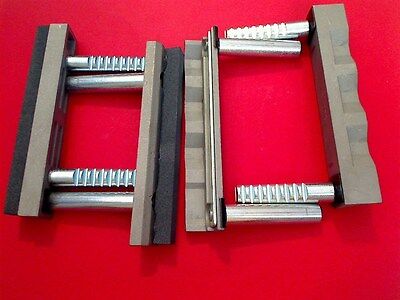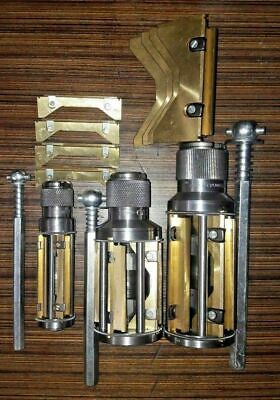Cyborg, the critical thing with typical Sunnen cylinder hones is they effectively only got 2 stones plus 2 wipers made of brass or some such. Sunnen warns about exclusively use just Sunnen hone oil - in hope and a lot of faith that stones and brass wipers will wear at same rate so as to have a 4 lines contact and hopefully roundness. So in case of the Jaguar block my bet the company used any other hone oil for cost cutting or whatever, not a matter of liner deformation, dry pressed in liner in Jags, or no liner at all. My production 6 stone hone remedied that flaw in a few minutes, could feel the chatter bodily as I used a mobile hone equipment. So no way I´d have that type of Sunnen for cylinder jobs, you´d be safer with Indian 4 stone hones like in link below. Last year I got a 5 stone hone from China for cylinder jobs at reasonable money. Seems they have good reason to specify a multitude of stones when machining big bores for all sorts of industry needs.
The small Sunnen types are a different thinking, only one stone is possible at small sizes, so on opposite side there must be brass guides for preventing chatter, centering and roundness. Again, for lower links honing is one way but not the most practical or cheapest. Bearing seats, and definitely in Vincents , don´t get honed typically, just fine bored. And in our case line reaming is the most economic way, in time and costs too, even with new reamer compared to Sunnen money. The reamer has got some more uses once in your household.
The thing about out of round is an interesting case you will know from sheet metal drilling with spiral drill: You will have seen a kind of triangle shape with rounded edges, not a round hole , when the drill is relieved a bit too much. So you will get same measured diameters at any position, the diameter is that of the drill certainly. But provided the drill does not cut dramatically oversize from poor sharpening you cannot get the shank of the drill enter the sheet metal hole. Reason: The drill got two flutes , not 4 or more, so poor centering action . Drills with 3 flutes are better - or deep hole power coolant drills with carbide tips got one single cutting tip but get centered by the rest of the circumference of the carbide top - a very different kind of tech.
So this is one example of same diameter shapes but no roundness , with 3 or 5 or 7 whatever "lobes" in a hole , a flaw you cannot easily measure with internal mics, two point or three point, difficult to measure but there ! You´d get your mill and lever indicator in the spindle for detecting the "lobes" . As I had all my professional life in injection mould tooling lots of ejector pin reamed holes to do, typically with solid HSS reamers, spiral flutes mostly, starting with 3 flutes from 1 mm up , all sizes. Common reamers got symmetric flutes, meaning equal angles between cutting edges. Consequence from this you could have spiral shapes in the holes like when looking into a rifle barrel. The reamer could be pushed through up to its shank but not more and the ejector pin would not fit either. So for removing that rifle shape you got a straight flute reamer out and run it through the hole. Modern high precision reamers, mainly carbide types, got the uneven angle geometry for perfect roundness, see photo of a few types below. That is why I warn from getting adjustable reamers with even spaced blades - useless !!
And no, I don´t need surface test equipment, got precision eyesight, see lapped conrods below. And judgements about reaming operation accuracy may reflect the quality and condition of reamers used , not about suitability of these tools. Plus you can save costs for a Sunnen honing machine which is unlikely to be available in a typical Vincent shed I´d think.
Vic
typical Sunnen cylinder hones, 2 stones, 2 brass wipers:

Indian 4 stones hone:

lapped conrod:


unevenly spaced reamers:

The small Sunnen types are a different thinking, only one stone is possible at small sizes, so on opposite side there must be brass guides for preventing chatter, centering and roundness. Again, for lower links honing is one way but not the most practical or cheapest. Bearing seats, and definitely in Vincents , don´t get honed typically, just fine bored. And in our case line reaming is the most economic way, in time and costs too, even with new reamer compared to Sunnen money. The reamer has got some more uses once in your household.
The thing about out of round is an interesting case you will know from sheet metal drilling with spiral drill: You will have seen a kind of triangle shape with rounded edges, not a round hole , when the drill is relieved a bit too much. So you will get same measured diameters at any position, the diameter is that of the drill certainly. But provided the drill does not cut dramatically oversize from poor sharpening you cannot get the shank of the drill enter the sheet metal hole. Reason: The drill got two flutes , not 4 or more, so poor centering action . Drills with 3 flutes are better - or deep hole power coolant drills with carbide tips got one single cutting tip but get centered by the rest of the circumference of the carbide top - a very different kind of tech.
So this is one example of same diameter shapes but no roundness , with 3 or 5 or 7 whatever "lobes" in a hole , a flaw you cannot easily measure with internal mics, two point or three point, difficult to measure but there ! You´d get your mill and lever indicator in the spindle for detecting the "lobes" . As I had all my professional life in injection mould tooling lots of ejector pin reamed holes to do, typically with solid HSS reamers, spiral flutes mostly, starting with 3 flutes from 1 mm up , all sizes. Common reamers got symmetric flutes, meaning equal angles between cutting edges. Consequence from this you could have spiral shapes in the holes like when looking into a rifle barrel. The reamer could be pushed through up to its shank but not more and the ejector pin would not fit either. So for removing that rifle shape you got a straight flute reamer out and run it through the hole. Modern high precision reamers, mainly carbide types, got the uneven angle geometry for perfect roundness, see photo of a few types below. That is why I warn from getting adjustable reamers with even spaced blades - useless !!
And no, I don´t need surface test equipment, got precision eyesight, see lapped conrods below. And judgements about reaming operation accuracy may reflect the quality and condition of reamers used , not about suitability of these tools. Plus you can save costs for a Sunnen honing machine which is unlikely to be available in a typical Vincent shed I´d think.
Vic
typical Sunnen cylinder hones, 2 stones, 2 brass wipers:

280 Grit Cylinder Hone Stone Set for AN-111 Sunnen Hone Range: 2.7 - 4.1 inch | eBay
280 Grit Hone Stone Set includes two holders with stones and two holders with aluminum wipers to fit Sunnen AN-series Portable cylinder hones and the AN-600 Mandrel. Use with honing oil. Sunnen / Rod Reconditioning.
www.ebay.de
Indian 4 stones hone:

Honwerkzeug Zylinder 34 - 165mm Motor Honen + Honsteine Beste Bluefox | eBay
Das Honwerkzeug kann mit einem Akku-Bohrer, einem pneumatischen Schraubendreher. 34-60mm + 16 x Honsteine. (1 Honahle + 16x Honsteine). 45-65mm + 16 x Honsteine. 50-75mm + 16 x Honsteine. 62-88mm + 16 x Honsteine.
www.ebay.de
Hongtuo Cylinder Hone Head - Buy Cylinder Honing Tool,Sunnen Honing Head,Honing Stone Product on Alibaba.com
Hongtuo Cylinder Hone Head - Buy Cylinder Honing Tool,Sunnen Honing Head,Honing Stone Product on Alibaba.com
www.alibaba.com
lapped conrod:
unevenly spaced reamers:
